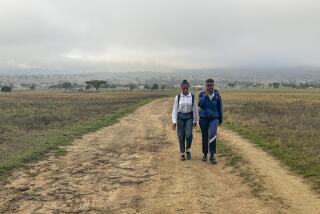South African museum celebrates activists’ struggle for liberation
- Share via
JOHANNESBURG, SOUTH AFRICA — Anti-apartheid activist Denis Goldberg spent his last day of freedom for 22 years on Liliesleaf Farm, a 28-acre swath of land in northern Johannesburg where African National Congress guerrillas such as Nelson Mandela plotted apartheid’s downfall.
“We weren’t super men and women,” the 74-year-old Goldberg said as he surveyed the farm, recently opened as an interactive museum. “We were just ordinary people who had a commitment.”
He urged visitors to “remember that freedom costs lives and liberty and struggle and dedication. It doesn’t just fall into your hands.”
On the outside, Liliesleaf looks just as Goldberg remembers. The building interiors, though, have received a high-tech makeover. In one room, visitors can touch sensors on a table to access audio-accompanied newspaper clippings, black and white photographs, text, and videos of famous activists. Center director Nicholas Wolpe, whose father, Harold Wolpe, was among the men arrested at Liliesleaf in 1963, says the feature is the first of its kind in the world.
“We don’t want a static experience; we want people to experience this place as what it was,” Wolpe said. “It was a hive of activity. It wasn’t a still frame.”
Visitors can see the veranda where Mandela held target practice, an outhouse once home to an underground printing press, and the thatched cottage where activists eventually were arrested as they discussed a military operation to be carried out by Umkhonto we Sizwe, the military wing of the ANC.
They also can see Mandela’s small, brick-walled bedroom, and listen to an old radio broadcast in the farmhouse kitchen where he first heard that ANC President Albert Luthuli had been awarded the 1960 Nobel Peace Prize.
The Liliesleaf museum opened June 9, but exhibit construction is still in progress. Wolpe says the center will continue to evolve as more of the farm’s history is uncovered. Much of its past is murky, and Wolpe and others are still conducting interviews to learn more about what happened there.
Liliesleaf became an apartheid opposition center in the early 1960s, after the South African government heightened its brutal crackdown on anti-apartheid activists and forced the resistance movement underground. The regime banned the ANC in 1960, the year that its troops shot and killed 69 civilians protesting the government’s repressive restrictions on movement in Sharpeville.
In 1962 the government imposed a state of emergency, one of several that would continue intermittently until 1989, when the apartheid regime began to founder.
The South African Communist Party, then in alliance with the ANC, purchased Liliesleaf in 1961 through a front company called Navian. Communist Party member Arthur Goldreich and his family pretended to be the owners of the farm, growing market produce and leasing land to neighbors.
Mandela lived at Liliesleaf for a short time, taking the name David Motsamayi and wearing blue overalls in an attempt to look like a farmworker. Some neighbors say they often saw “David” selling produce on the street outside the farm.
The raid on Liliesleaf led to the 1964 Rivonia treason trial, during which Mandela made his “I am prepared to die” speech, and testimony recounting apartheid’s evils focused international attention on South Africa’s racist regime.
Mandela wasn’t arrested in the Liliesleaf raid; he was already in prison for inciting workers to strike and leaving the country without a passport. Other defendants in the trial included Walter Sisulu and Govan Mbeki, father of current South African President Thabo Mbeki. Eight of the 10 defendants were sentenced to life, and two were acquitted.
“I have no regrets,” said Goldberg, a South African Communist Party member who was the only white person sentenced to life in Rivonia. “What we did was right. We just should have done it better and not got caught.”
No one knows how Liliesleaf was exposed. Some suspect CIA involvement, others place the blame on an opportunistic snitch, and some believe an insider confessed during interrogation.
By 1963, suspecting Liliesleaf was no longer secure, resistance leaders had bought a farm west of Johannesburg for their new headquarters. A meeting July 11, 1963, was to have been the last of its kind at Liliesleaf. The day of the final meeting, Goldberg and others went to visit the new farm.
About 45 minutes after they returned to Liliesleaf, activists were discussing a plan to overthrow South Africa’s racist regime when a van drove up the dusty driveway. Before anyone could ask farmworkers about the unannounced vehicle, armed policemen burst out and arrested everyone in sight.
“We were taken to the Old Fort,” a Johannesburg prison, “and I was looking around the night sky when I got there,” Goldberg recounted.
“And one of the police said, ‘Don’t think you’re going to escape.’ And I said, ‘No, I’m just looking at the night sky. I don’t think I’m going to see it for a long time.’
“And I don’t think I saw the night sky for the next 22 years.”
More to Read
Sign up for The Wild
We’ll help you find the best places to hike, bike and run, as well as the perfect silent spots for meditation and yoga.
You may occasionally receive promotional content from the Los Angeles Times.






